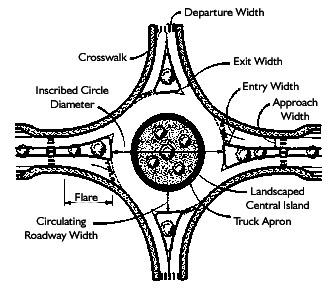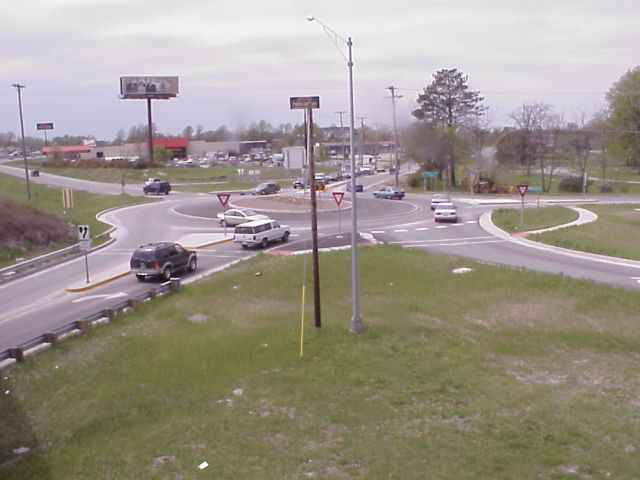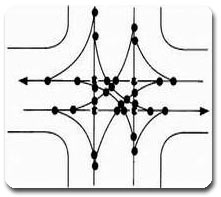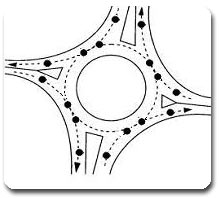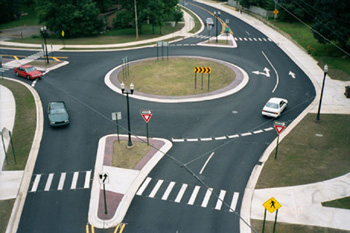
A safe and efficient transportation system is a key component of this regions quality of life. It has direct bearing on mobility and the accessibility of people and goods to employment, shopping, and other opportunities; economic development; and the patterns of growth in the region. In many respects, the Genesee-Finger Lakes regions transportation system provides it with a comparative advantage over many other areas in the state and nation. The application of roundabouts at some intersections in our region may help enhance the safety and efficiency of these intersections and the transportation purposes they serve.
A roundabout is a circular intersection joining two or more streets. The streets that connect to a roundabout feed traffic into a circulatory roadway that surrounds a central island. Traffic on the circulatory roadway flows in a counterclockwise direction. All turns and lane changes that drivers make when entering, while within, and when leaving a roundabout are right turns, which adds both to the ease, efficiency, and safety with which drivers pass through roundabouts.
Roundabouts are not appropriate for all intersections but they may be appropriate in the following situations:
-
Intersections with a history of accidents;
-
Intersections where vehicle queues need to be minimized;
-
Intersections with irregular approach geometry;
-
Intersections in need of less expensive traffic control operations (as opposed to a traffic signal);
-
Intersections with a high proportion of U-turns; and/or
-
Intersections with abundant right-of-way
As a driver approaches the entrance to a roundabout, he/she slows down and, if possible, merges with traffic on the circulatory roadway (the roundabout) without stopping. A Yield Sign controls each entrance into a roundabout. There is no need to stop completely if space is available within the roundabout to enter. Once in the roundabout, drivers move slowly with traffic around the central island. Speeds of 10 to 15 mph are typical for small roundabouts and 20 to 30 mph for larger roundabouts. When a driver approaches his/her desired exit, they use their right turn signal and make the right turn needed to leave the roundabout.
|
|
Comparison of Roundabouts and Traditional Signalized Intersections
Intersection Efficiency
Roundabouts permit a continual stream of traffic to flow through the intersection, whereas a signalized intersection requires traffic to stop completely in one direction. Therefore, roundabouts are usually more efficient in keeping traffic in motion, thus reducing traffic congestion.
Potential Air Quality Benefits
Since vehicles pass through roundabouts without stopping to wait in lines like those that sometimes form at traffic signals, pollution levels at intersections may decrease because the incidence of idling motor vehicles is reduced.
Enhanced Safety
A roundabout relies on the geometry of the circular roadway to control traffic as opposed to the authority of traffic signals or regulatory signs. In contrast, at standard intersections there are no physical barriers, like the center island of a roundabout, to prevent vehicle operators from running a stop sign or traffic light. As such, travelers of all modes benefit because:
-
Vehicles approach and travel through roundabouts at low speeds, giving them more time to prepare for the intersection and to react to traffic around them;
-
Lower travel speeds through a roundabout versus a traditional signalized intersection typically mean that even when a collision occurs, damages and injuries are less severe than in high-speed collisions; and
-
Roundabouts significantly reduce the number of vehicle conflict points in the intersection, so drivers have fewer opportunities to cross paths with other cars, bicyclists, and pedestrians. In the figures below, each dot represents a potential conflict point.
|
|
|
|
In a traditional four-legged intersection, over 30 potential conflict points are created when through, right, and left turning movements are considered |
In a roundabout, there are half as many potential conflict points as compared to a traditional four-legged intersection. |
A recent safety study of modern roundabouts highlights the traffic safety benefits of roundabouts in comparison to signalized intersections in the locations examined:
|
Average Annual Crash Frequencies at eleven (11) Signalized Intersections Converted to Roundabouts |
||||
|
Percent Change |
||||
|
Type of Roundabout |
Roundabout Sites |
Crash Reduction |
Injury Reduction |
Property Damage Only Crash Reduction |
|
Single-Lane Roundabout |
8 |
-51% |
-73% |
-32% |
|
Multi-Lane Roundabout |
3 |
-29% |
-31% |
-10% |
|
Total |
11 |
-37% |
-51% |
-29% |
Source: Synthesis of Highway Practice 264: Modern Roundabout Practice in the United States. National Cooperative Highway Research Program, Washington DC, 1998.
Lower Cost
Generally, roundabouts are cheaper to build and maintain than signalized intersections. Most of the regular maintenance costs of roundabouts are related to landscaping, lighting, and standard roadway maintenance (e.g. snowplowing, street cleaning). However, the cost to acquire new right-of-way should be factored in if there is not adequate right-of-way at the existing intersection. Typically, roundabouts require more right-of-way than traditional intersections controlled by traffic signals or stop signs.
U-Turns Allowed
Roundabouts accommodate Uturns, allowing drivers to simply circle all the way around the central island and exit the roundabout on the same street they entered it from.
Improved Aesthetics
The central island of a roundabout provides a location for landscaping and/or a landmark feature. This feature improves the aesthetic value of an intersection and enables the roundabout to serve as a gateway to a particular community or street.
Special Considerations and Concerns with Roundabouts
Driver Inexperience
The typical American driver has little to no experience with roundabouts. As such, crash rates on newly built roundabouts might be higher than average for a while after the roundabout opens. As time passes and drivers become more comfortable with the roundabout, crashes of all types typically decrease.
Pedestrians Traveling through Roundabouts
Since traffic is continually flowing in and out of the roundabout and is not controlled by a signal, there is no time when a pedestrian can be reasonably certain that a vehicle will not pass over the crosswalk. Roundabouts can also be difficult for visually impaired pedestrians to determine the moment when it is safe to cross as many utilize traffic sounds to determine when a roadway is clear. Additionally, the route pedestrians must take around a roundabout is longer than the route they would take to walk through many signalized intersections.
Bicyclists Traveling through Roundabouts
Bicyclists can travel through a roundabout either as a vehicle (within the roundabout) or as a pedestrian (walking their bicycle). Some multi-lane roundabouts utilize an adjacent one-way trail where bicyclists approach the roundabout on-street, merge with the side trail via a ramp, travel around the roundabout on the trail, and then re-merge with the street via another ramp. This option presents some challenges with motor vehicles yielding at crossing points (similar to pedestrian issues described above). Notably, the reduced speeds of motor vehicles within the roundabout more closely match a bicyclists typical speed range (approximately 10 - 20 mph).
Emergency Vehicles
Emergency vehicles cannot speed through a roundabout like they can a signal light; they need to slow down and pass through the circle like regular traffic. Additionally, traffic signals offer the option for signal preemption to provide the green light to emergency vehicles; roundabouts require travelers to yield to emergency vehicles.
Lighting
Illumination costs may be greater for a roundabout than a standard intersection as more lighting is typically required. More lighting may also be a concern of adjacent property owners, especially near residential areas
Snow Removal
As with any new roadway configuration, highway maintenance staff will need to learn new snowplowing techniques. Notably, some of the earliest modern roundabouts in the United States were constructed in Vail, Colorado, an area that receives a significant amount of snowfall annually.
Parking
The construction of a roundabout to replace an existing traditional signalized intersection may result in the loss of some on-street parking if allowed near the former intersection.
Right-of-Way Requirements
The construction of a roundabout typically requires more right-of-way than a traditional intersection controlled by traffic signals or stops signs, which may increase the cost of a roundabout installation if right-of-way must be purchased.
-
New York State Department of Transportations On-Line Roundabout Resources - Provides roundabout information and guidance for both transportation professionals and laypersons, including photos of some existing roundabouts and photo simulations of proposed roundabouts in New York State
-
Roundabouts: An Informational Guide Federal Highway Administration (FHWA) - The Federal Highway Administrations flagship study on roundabouts in the United States. Chapters include policy considerations, planning, operation, safety, design, landscaping, and system considerations
-
Roundabouts USA - Information on the history of roundabouts in the United States, roundabout design, and numerous photos of roundabouts in the U.S.
-
Maryland State Highway Administrations Traveling Marylands Roundabouts - The State of Marylands roundabout web site, which includes information on roundabouts in the state and a very detailed Frequently Asked Questions (FAQs) section
-
Oregon Department of Transportations Roundabout Web Page - Includes information on roundabout siting criteria, observations by ODOT staff on existing roundabouts, and a link to ODOTs 1998 report, Modern Roundabouts for Oregon
-
Kansas State University Center for Transportation Research and Training - Extensive collection of photos of roundabouts around the United States as well as other web resources on roundabouts
-
Lounsbury and Associates: Roundabout Resources - Informative web site with information on all aspects of roundabouts, including detailed information on accommodating pedestrians and bicyclists in roundabouts, history of the modern roundabout, and links to more Internet resources
